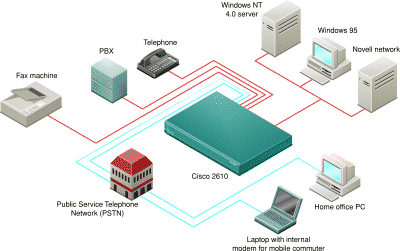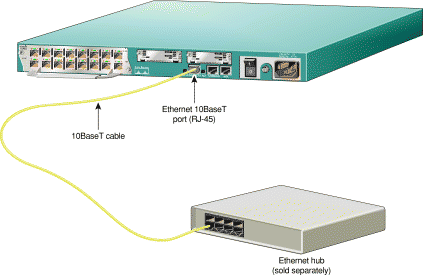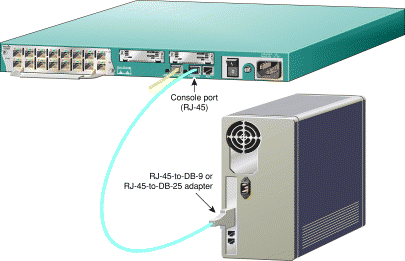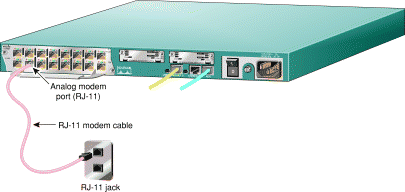|
|


This guide explains how to cable and set up your Cisco 2610 router with the following configuration:
Begin by taking out the following items from the box. | Note If your router has a different hardware configuration, refer to the Cisco 2600 Series Hardware Installation Guide for information on how to install and set up your router.
|
1 Quick Start Guide (this guide) with | |
1 Cisco 2610
| |
1 yellow Ethernet 10BaseT cable
|
|
1 flat, light-blue console cable with
| |
8 or 16 pink modem cables (RJ-11)
| |
1 black power cord | |

Use this procedure, if required, to install an 8- or 16-port analog modem network module in a Cisco 2610 router.
Look for a network module in the slot labeled 1 on the left-rear of the router. If there is an analog modem network module already installed, continue to cable the router as described in this guide.
If you need to install an analog modem network module, follow this procedure:
1. Use a Phillips screwdriver to remove the screws that hold the metal plate over the network module slot cover and remove the metal covering plate.
2. Hold the network module by the handle and line the module up with the guides on either side of the slot.
3. Push the module into place until the edge connector is securely seated in the connector on the motherboard. Ensure that each of the module's captive screws line up with their hole in the chassis.
4. Secure the captive mounting screws into the holes of the chassis using a Phillips screwdriver.
5. Connect the appropriate network module cable(s) to your network.
For information on connecting network modules, refer to the Cisco Network Modules Hardware Installation Guide included in your router package.

Position the router so you can reach the rear panel. The cables and the router's ports are color-coded to help you make the right connections.
1. Connect one end of the yellow Ethernet cable into the yellow Ethernet 10BaseT (RJ-45) port labeled ETHERNET 0/0 on the rear panel of your router.
2. Connect the other end of the yellow Ethernet cable into any available port on your 10BaseT hub or switch (not included).
3. Make sure a PC (running Windows NT 4.0 or Windows 95) is connected to the Ethernet LAN. You will use this computer in the procedure on page 9 to run Cisco Fast Step software to configure the router.

1. Connect the light-blue console cable to the light-blue port labeled CONSOLE on the rear panel of the router.
2. Connect the other end of the light-blue console cable to an RJ-45 adapter.
3. Attach the adapter to a serial port on the PC running Windows NT 4.0 or Windows 95.

The Cisco 2610 router comes with an 8- or 16-port internal analog modem module. Use these ports to connect up to 16 modems.
| TimeSaver Start by connecting only one modem. After you have configured the router settings for this modem and completed the procedure on page 9 successfully, connect and set up the remaining modems. |
1. Connect one end of the pink modem cable to one of the numbered modem ports (also pink) on the router's rear panel.
2. Connect the other end of the pink modem cable to an RJ-11 telephone wall jack or an RJ-11 outlet in your wiring closet.
If you followed the suggestion, in the Timesaver section on this page, and only connected one cable, you will have to connect the remaining modem cables after you configure and test the router. See page 10, for information on how to finish the cabling.

1. Connect one end of the black power cord to the power connector on the router's rear panel.
2. Connect the other end of the power cord to an electrical outlet.
3. Turn ON the power switch on the rear panel. The green Power LED on the router's front panel blinks, as the router initializes, then stays on when fully initialized. (It might take a moment before this light goes on.)
4. Perform a quick visual inspection to ensure the following:
— The router is plugged in, the power is turned on, and the Power LED on the front panel displays a solid green light. (If not, you cannot install the Cisco Fast Step software.)
— The link LED (labeled LNK) next to the Ethernet port, displays a solid green light. (If this is not a solid light, check your cabling.)
— Each modem port you are currently setting up has a pink modem cable connected to it.
— Each pink modem cable connected to a modem port is also connected to an RJ-11 telephone wall jack or outlet.
You are now finished cabling the router and one or more modems. The next section explains how to run Cisco Fast Step software so you can use the router in your network.
| TimeSaver Cisco Fast Step software prompts you for network information according to the routing protocols you select. Before you run the software, make sure you have this information available or know where to get it (usually from the network administrator). For your convenience, a form prompting you for setup information is on page 11. |
1. Insert the Cisco Fast Step CD-ROM (attached to inside back cover of this guide) into the CD-ROM drive of the local PC to which you connected the LAN on page 5.
2. The Fast Step install program starts Setup.exe automatically. If it does not, follow these steps:
(a) Double-click the My Computer icon.
(b) Double-click the CD icon.
(c) Double-click the Setup.exe icon.
Once installed, the Cisco Fast Step Setup program starts automatically. Follow the onscreen instructions to guide you through configuring and testing the router.
Perform this test to verify the modem connection and the router configuration are good. This section assumes the remote PC you are using for the test runs Windows NT 4.0 or Windows 95.
1. Double-click the My Computer icon on the desktop of the remote PC.
2. Double-click the Dial-Up Networking folder. (If you do not find this folder, refer to the Microsoft documentation to install the software.)
3. Double-click the Make New Connection icon.
4. Follow the onscreen instructions to create and name a new connection icon to test the modem connection and the router configuration. When prompted for the area code and telephone number, enter the appropriate number of the modem you are testing.
5. Double-click the new connection icon you created in Step 4 and enter the username and password (as defined when setting up Fast Step). Verify that the telephone number is the correct number for the modem you are testing.
6. Go to page 10 to connect the remaining modem cables, if necessary.
This section applies only if your are connecting more than one modem.
If you connected one modem in the procedure on page 7, you are now ready to cable the rest of your modems. How you do this depends on the way you organize your workspace and your own personal preferences.
The following suggested procedure helps you simplify the job by keeping the connections neat and orderly and by providing a reliable process.
1. Make sure you can reach the router's rear panel.
2. Pick up a pink modem cable and connect one end into one modem port (also pink) of the access server.
3. Repeat Step 2 with the remaining pink modem cables.
4. Connect the other end of each of the pink modem cables from Step 3 into an RJ-11 wall jack or into an RJ-11 outlet in your wiring closet.
5. Tie-wrap your cable bundles.
6. To help with maintenance and troubleshooting, write down the access server port number and telephone wall jack for each modem. Keep this record in a safe place.
This appendix is provided to help you gather and organize the information you need to run the Cisco Fast Step software on page 9.
Router name:
Router password (for read-only access):
Super secret password (for read/write access):
IP address:
Subnet mask:
Specify the starting range (up to 16 in range) or IP address list.
Range start:
IP address list:









Internet router IP address (optional):

IPX network number of LAN side of router:
IPX Frame type (802.3, 802.2, Ethernet II, or SNAP):
ARAP network number:
Zone name:
Cable range start:
Cable range end:
User list user IDs:
User list password:
Cisco security server IP address:
Cisco security server key:
![]()
![]()
![]()
![]()
![]()
![]()
![]()
![]()
Posted: Wed Sep 25 07:47:07 PDT 2002
All contents are Copyright © 1992--2002 Cisco Systems, Inc. All rights reserved.
Important Notices and Privacy Statement.